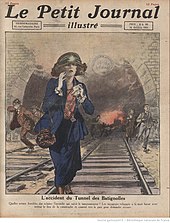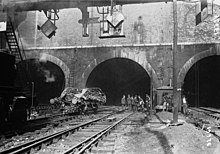Railway accident in the Batignolles tunnel

The railway accident in the Batignolles tunnel in Paris was a rear-end collision between two trains on October 5, 1921, killing at least 28 people.
Starting position
The railway line from Gare Saint-Lazare to Versailles-Rive-Droite station led from the platform apron of Saint-Lazare station directly into the four parallel Batignolles tunnels that ran under the Paris metropolitan area. There was no tunnel lighting. The passenger cars themselves were then still equipped with gas lighting and all had wooden bodies.
the accident
The train No. 333, which was supposed to go to Versailles-Rive-Droite, left the station. In the tunnel , the engine driver noticed that he had lost some cars and stopped. A next train, which was scheduled to leave the station four minutes later, inadvertently also received permission to exit and drove into the wagons that the first train had lost in the smoky tunnel in complete darkness. The gas container of the gas lighting in a car was damaged, gas leaked and ignited. The fire spread to four other cars. This also injured many travelers who tried to escape the tunnel on foot.
consequences
At least 28 people died in the collision and the subsequent fire . As a result of the accident , the gas lighting on the French railways was completely abandoned and replaced by electric light . Three of the Batignolles tunnel were 1921-1926 slit and the fourth reduced to 321 meters.
literature
- Max Büttner: The lighting of railway passenger cars with special consideration of the electrical lighting . 4th edition, Berlin 1930.
- Philippe Callé: 1,700 train journeys a day . In: Railways in Paris = Railway History Special 2 (2015), pp. 8–15.
- Report in: De Rijnbode of October 8, 1921, p. 1 (Dutch; digitized ).
- Thomas Samek: Save yourself who can! . In: Eisenbahn-Kurier 10/2002, pp. 55–57 ( online ).
Web links
- Terje Andersen: Railroad and Metro Tunnel Accidents (English)
Individual evidence
Coordinates: 48 ° 53 '0.1 " N , 2 ° 17' 39.8" E
